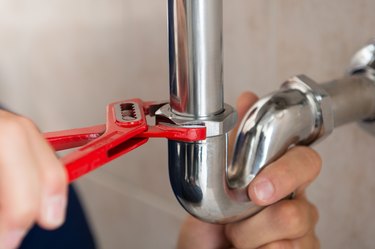
When you see water on the bottom of the cabinet under the kitchen sink, it means a pipe or a pipe connection is leaking. The first question to ask is "Which one?" The water could be coming from the sink drain or one of the faucet water supply hoses, and if you have a dishwasher, it could be coming from the dishwasher drain hose.
It's possible for a pipe or hose to spring a leak all on its own, but it's rare. It's far more likely for water to leak from a bad connection, and fortunately, every connection under the sink is easy to tighten. When tightening connections doesn't do the job, things may be complicated enough to warrant calling a plumber.
Video of the Day
Video of the Day
Diagnose the Leak Source
You can't stop a leak until you know where it is, and the first clue is the part of the cabinet base that's wet. If it's at the rear of the cabinet, suspect the faucet hose connections, and if it's centered right under the sink, water is probably dripping from the sink drain assembly, which includes the P-trap and the dishwasher hose connection. If the dishwasher has an air gap, which is a dome-shaped fitting on the sink deck required in several states, according to Fresh Water Systems, the water could also be coming from there.
Go under the cabinet with a flashlight and inspect the faucet hoses. You may see water dripping or spraying from a faucet connection, and if so, there's your leak. If the faucet isn't leaking, fill the sink with water, then let it drain and watch for water dripping from the P-trap assembly as the water flows. Finally, run the dishwasher through a rinse cycle and watch the air gap connections when water drains.
Stop a Faucet Hose Leak
If you see water spraying or dripping from one of the faucet hoses, you can usually stop it by tightening the connection with tongue and groove pliers. If you don't have any luck, turn off the water, unscrew the connection and check inside the hose connector for a crooked or worn washer. Most faucet connectors are compression fittings, so plumbing tape probably won't help, but it doesn't hurt to give it a try.
If water is spraying from the handle of one of the shutoff valves, you'll have to replace that valve. This is a job for which you have to turn off the water to the kitchen. If the valve is soldered, you may need a plumber. If the valve is screwed on with a compression fitting, though, it's a straightforward job to unscrew it and screw on a new one, and you can probably do that yourself.
Stop a Leak in a Drain Assembly
If you see water dripping from one of the compression nuts holding the P-trap together, you may be able to tighten the nut enough by hand to stop the leak. If not, use tongue-and-groove pliers. If that doesn't work, disassemble the connection and replace the plastic flanged washer. Leaks from the dishwasher drain hose usually occur because of a loose pipe clamp, and these clamps have a screw that you can tighten with a screwdriver.
One more possibility is that water is coming from the sink drain strainer, and when this happens, you will see water dripping from the sink when it's full of water. This repair can be a bit complicated, because it involves disassembling the P-trap, removing the garbage disposal and removing the sink strainer so you can pack it with plumber's putty, as demonstrated in this YouTube video. Unless you like plumbing, this is another job for which you might consider hiring a pro.